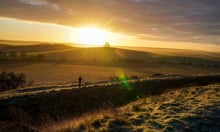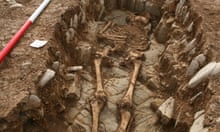The head of a dog that lived on Orkney 4,500 years ago has been recreated in what experts believe is the world’s first canine forensic reconstruction.
The dog had been domesticated in the Neolithic era on the Scottish island archipelago, but still carried wolf-like characteristics, standing about the size of a large collie, according to Historic Environment Scotland (HES) which jointly commissioned the reconstruction with the National Museum of Scotland.
It was reconstructed by a forensic artist – using techniques similar to those by crime scene investigators – from one of 24 dog skulls that were excavated by archaeologists in Cuween Hill, a delicate passage tomb on Orkney’s Mainland, and which have been radiocarbon-dated to 2,500BC.
The tomb had been built, using a similar intricate corbelling technique to that used at the better-known monument Maeshowe, about 600 years earlier and used for human burial. The reason for the later deposit of canine remains is a mystery. “People have speculated as to whether the fact you get so many dogs in one tomb, which is very, very unusual, suggests there was some kind of totemic thing,” said Alison Sheridan of the National Museum of Scotland.
Two other tombs in Orkney have been found to have similar strange animal associations – in one, on the island of South Ronaldsay, a local farmer found a large number of bones and talons belonging to sea eagles, while the evocatively named Knowe of Yarso on Rowsay was found to contain the bones of 36 red deer.
“Perhaps the people who lived in the [Cuween Hill] area at the time saw themselves as ‘the dog people’,” said Sheridan, who is principal archaeological research curator in the department of Scottish history and archaeology. She said the groups living around the other tombs may have identified with the other species. “For some reason, many generations after these tombs were built, people had a special association with different kinds of animals.”
Steve Farrar, HES’s interpretation manager, said the dog had been reconstructed as part of an attempt to bring alive the stories behind Orkney’s large number of Neolithic monuments and those who built them, “to bring us closer to who they were and perhaps give a little hint of what they believed”. The spate of monument-building in Orkney during the Neolithic period is believed to have been hugely influential to communities across Britain and Ireland and beyond.
This article includes content hosted on sketchfab.com. We ask for your permission before anything is loaded, as the provider may be using cookies and other technologies. To view this content, click 'Allow and continue'.
“When you look at a Neolithic dog, it somehow communicates human relationships, and I can relate to that. I can empathise with the people whose ingenuity made Orkney such an enormously important place. When this dog was around, north-west Europe looked to Orkney.”
Sheridan and Lisa Brown of the Society of Antiquaries of Scotland will discuss the reconstruction at the Edinburgh Science Festival on Saturday, while the dog’s head will go on display in Orkney later this year.










